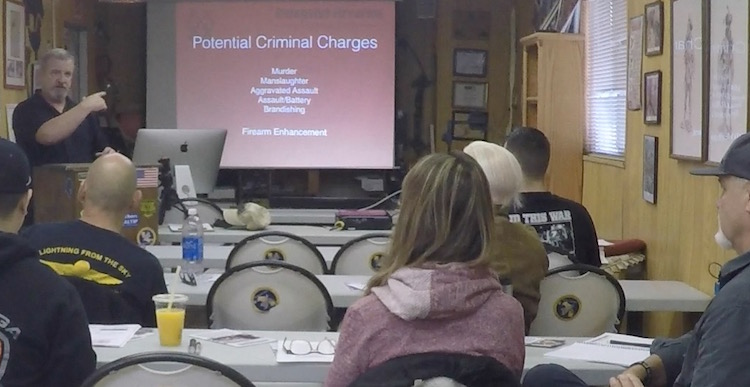
Defensive Firearms Instruction conducted a Use of Force and Self Defense Laws Class at Angeles Shooting Ranges. This class was an introduction into the world of criminal law and law enforcement procedures that is not often taught. However, in this increasingly litigious world where even the most righteous acts of self-preservation are microscopically criticized with vicious social bias, it is imperative that a personal defense plan include more training than came in the gun box. When contemplating the legal aftermath and potential consequences of a deadly-force incident, the knowledge on how to become “hard to convict” is most valuable. Jeff Cooper referred to this as the Second Battle.
The class started off with a video clip of a couple out for a walk in a semi-remote park area. When they are suddenly targeted in a “knock-out” style attack the realities of violence immediately grabbed the DFI students’ attention. Even though the video clip was a planned and supervised stress inoculation training exercise, it graphically demonstrated how fast and how violent people can be to each other. The audience was then challenged, with their present level of legal knowledge on the topic, to justify the actions of the defender in this “pre-quiz”. Some tactical answers were proffered, but this class was more about the legalities of a defender’s actions, not whether or not the tactics were “good”. This set the tone for the remainder of the day where vigorous student-instructor interaction was a constant theme. Learn the laws of use of force. Be able to legally justify your use of force. Stay out of jail.
Topics of the class included Sources of Law, Elements of Lawful Self-Defense, Potential Criminal Charges, Third-Party Defense, Defense of Property, Guilty Mind, Interaction with Law Enforcement, and Developing a Sound Legal Strategy. Of special interest was the Specialized Knowledge discussion of how a jury may be “educated” as to a defender’s training, education, and experience and the importance of being able to legally “prove” that knowledge. The Tueller Drill, OODA Loop, Average Reaction Times, and Pre-Attack Indicators were introduced, discussed, and witnessed with video clips. A printed copy of the presentation was an available option to assist the students in taking personal notes and served as a tangible record of their training documentation to show proof of prior specialized knowledge to a jury in the event they become forced to engage in the Second Battle after winning the first.
As difficult as it was to compete with learning to shoot guns, the tempo of the class went along briskly with lots of questions and raised eyebrows after hearing some of the unpleasant answers. All sorts of learning was happening. The students all were appreciative of the experience being offered to them from the first-hand perspective of someone dealing with dangerous people over a law enforcement career.
It is likely that an enhanced version of this class involving low-level stress and decision making scenarios will be well received. It’s one thing to sit in a classroom and ruminate on the actions of others while you are not anxious, scared, confused, injured, or taken by surprise. It’s quite another to be forced into making life-changing decisions and then being minutely scrutinized over months or years when your decision to act involved seconds. Realistic training can only help.
Contact Riley to inquire about learning to become, “hard to convict”.
